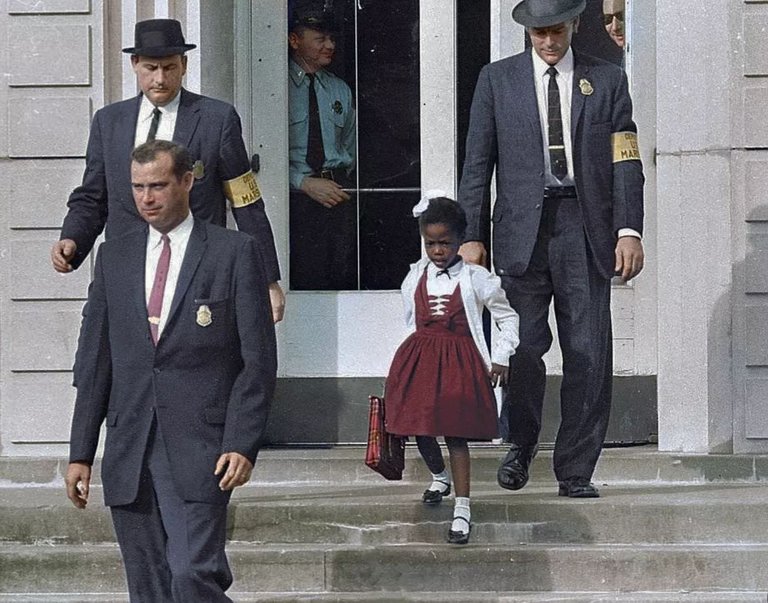As the first black student to attend an all-white school, 6 year old Ruby Bridges is escorted by US Marshalls during her first year at William Frantz Elementary in Louisiana.
Bridges was one of six black children in New Orleans to pass the test that determined whether they could go to the school. Two of the six decided to stay at their old school, Bridges went to a school by herself, and three children were transferred to McDonogh No. 19 and became known as the McDonogh Three. Bridges and her mother were escorted to school by four federal marshals during the first year Bridges attended William Frantz Elementary.
Ruby's father was initially reluctant, but her mother felt strongly that the move was needed not only to give her own daughter a better education but to "take this step forward ... for all African-American children". As Bridges describes it, "Driving up I could see the crowd, but living in New Orleans, I actually thought it was Mardi Gras. There was a large crowd of people outside of the school. They were throwing things and shouting, and that sort of goes on in New Orleans at Mardi Gras." Former United States Deputy Marshal Charles Burks later recalled, "She showed a lot of courage. She never cried. She didn't whimper. She just marched along like a little soldier, and we're all very very proud of her."
As soon as Bridges entered the school, white parents pulled their own children out; all the teachers refused to teach while a black child was enrolled. Only one person agreed to teach Ruby and that was Barbara Henry, from Boston, Massachusetts, and for over a year Henry taught her alone, "as if she were teaching a whole class."
That first day, Bridges and her adult companions spent the entire day in the principal's office; the chaos of the school prevented their moving to the classroom until the second day. On the second day, however, a white student broke the boycott and entered the school when a 34-year-old Methodist minister, Lloyd Anderson Foreman, walked his 5-year-old daughter Pam through the angry mob, saying, "I simply want the privilege of taking my child to school ..." A few days later, other white parents began bringing their children, and the protests began to subside. Every morning, as Bridges walked to school, one woman would threaten to poison her; because of this, the U.S. Marshals dispatched by President Eisenhower, who were overseeing her safety, allowed Ruby to eat only the food that she brought from home.
The Bridges family suffered for their decision to send her to William Frantz Elementary: her father lost his job, the grocery store the family shopped at would no longer let them shop there, and her grandparents, who were sharecroppers in Mississippi, were turned off their land. She has noted that many others in the community, both black and white, showed support in a variety of ways. Some white families continued to send their children to Frantz despite the protests, a neighbor provided her father with a new job, and local people babysat, watched the house as protectors, and walked behind the federal marshals' car on the trips to school.
For more images and details from events in 1960 check out History0x

Source
Plagiarism is the copying & pasting of others work without giving credit to the original author or artist. Plagiarized posts are considered fraud and violate the intellectual property rights of the original creator.
Fraud is discouraged by the community and may result in the account being Blacklisted.
If you believe this comment is in error, please contact us in #appeals in Discord.